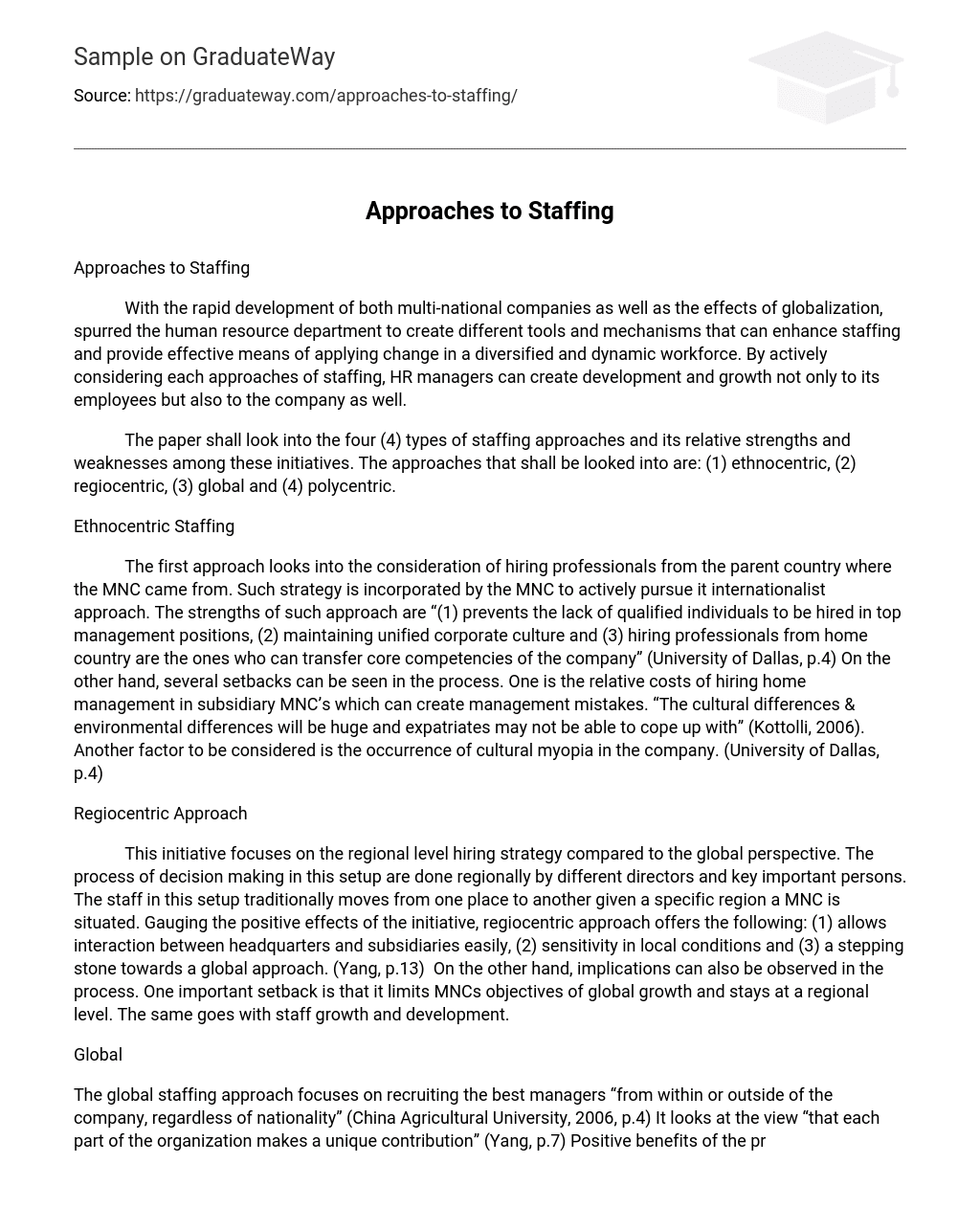With the rapid development of both multi-national companies as well as the effects of globalization, spurred the human resource department to create different tools and mechanisms that can enhance staffing and provide effective means of applying change in a diversified and dynamic workforce. By actively considering each approaches of staffing, HR managers can create development and growth not only to its employees but also to the company as well.
The paper shall look into the four (4) types of staffing approaches and its relative strengths and weaknesses among these initiatives. The approaches that shall be looked into are: (1) ethnocentric, (2) regiocentric, (3) global and (4) polycentric.
Ethnocentric Staffing
The first approach looks into the consideration of hiring professionals from the parent country where the MNC came from. Such strategy is incorporated by the MNC to actively pursue it internationalist approach. The strengths of such approach are “(1) prevents the lack of qualified individuals to be hired in top management positions, (2) maintaining unified corporate culture and (3) hiring professionals from home country are the ones who can transfer core competencies of the company” (University of Dallas, p.4) On the other hand, several setbacks can be seen in the process. One is the relative costs of hiring home management in subsidiary MNC’s which can create management mistakes. “The cultural differences & environmental differences will be huge and expatriates may not be able to cope up with” (Kottolli, 2006). Another factor to be considered is the occurrence of cultural myopia in the company. (University of Dallas, p.4)
Regiocentric Approach
This initiative focuses on the regional level hiring strategy compared to the global perspective. The process of decision making in this setup are done regionally by different directors and key important persons. The staff in this setup traditionally moves from one place to another given a specific region a MNC is situated. Gauging the positive effects of the initiative, regiocentric approach offers the following: (1) allows interaction between headquarters and subsidiaries easily, (2) sensitivity in local conditions and (3) a stepping stone towards a global approach. (Yang, p.13) On the other hand, implications can also be observed in the process. One important setback is that it limits MNCs objectives of global growth and stays at a regional level. The same goes with staff growth and development.
Global
The global staffing approach focuses on recruiting the best managers “from within or outside of the company, regardless of nationality” (China Agricultural University, 2006, p.4) It looks at the view “that each part of the organization makes a unique contribution” (Yang, p.7) Positive benefits of the program include: “(1) ability of the firm to develop an international executive team, (2) overcome the federation drawback which can be seen in the polycentric approach and (3) support cooperation and sharing of resources among units” (Yang, p.14). On the other hand, setbacks and challenges are also in place which include (1) immigration controls, (2) relative costs of transfer and training and (3) reduce independence of subsidiaries in management. (Yang, p. 13)
Polycentric Policy
This approach deals with hiring professionals to manage subsidiary companies of MNCs in their respective home countries while the key important management positions are handled at corporate headquarters. (University of Dallas, p.4) One important benefit of such initiative is it prevents the occurrence of cultural myopia. In addition, the relative costs of staffing are cheaper than the three policies. On the other hand, setbacks include “(1) limited capability and access to gain experience outside of their home country and (2) create gaps between subsidiary managers and parent country managers” (University of Dallas, p.5)
To conclude, all these staffing practices are put into place to give HR managers different approaches on how to address the conditions by the MNC both in the local and international setup. Each one presents their individual strengths and weaknesses. To promote one alternative over the other remains to be subjective since each MNC differs in scope and orientation. In the end, these mechanisms are placed to give advantage to companies. It only depends which one is suitable in their conditions which can enhance their overall productivity and growth.
References
China Agricultural University (2006) Chapter 9: Staffing, Training, and Compensation for
Global Operations in International Human Resource Management. Retrieved June 17, 2008 from 202.205.89.79/download/materials/2006s/discipline/international_hrm/CHAP09PP.PPT
Kottolli, A. (2006) International Staffing Strategy. Retrieved June 17, 2008 from
http://www.geocities.com/akottolli/International_Staffing_Strategy.htm
University of Dallas (n.d.) Chapter 15: Global Human Resource Management. Retrieved June
17, 2008 from www.utdallas.edu/~ixd031000/chap15.pp
Yang, D. (n.d.) Chapter 3: IHRM: Sustaining International Business Operations. Retrieved June
17, 2008 from userwww.sfsu.edu/~nyang/IBUS%20618/Chapter%203.ppt





